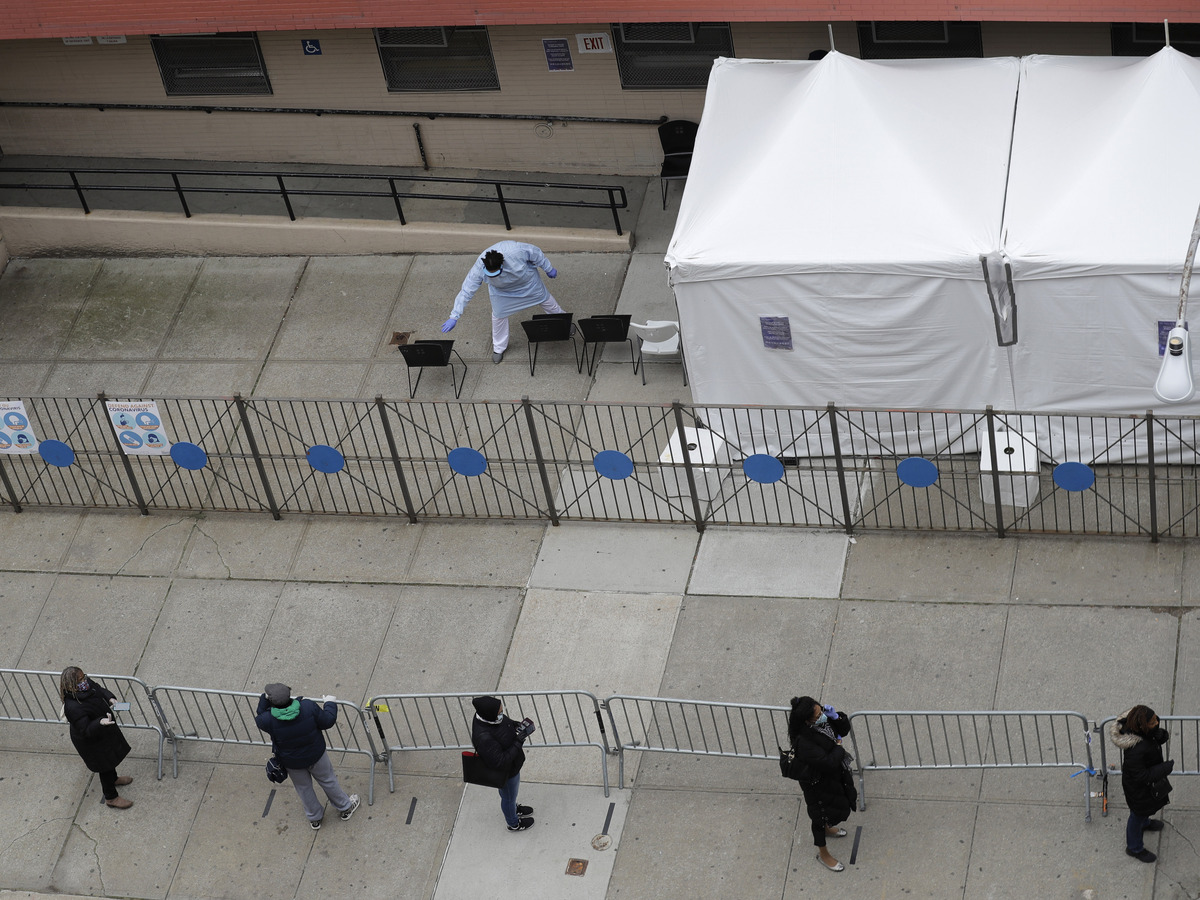


People stand in line at a coronavirus testing site in Harlem. In an effort to test more people for the virus, New York and other cities have begun offering door-to-door screening and at-home testing.
Seth Wenig/AP
hide caption
toggle caption
Seth Wenig/AP
People stand in line at a coronavirus testing site in Harlem. In an effort to test more people for the virus, New York and other cities have begun offering door-to-door screening and at-home testing.
Seth Wenig/AP
Multiple cities have started door-to-door coronavirus screenings and testing in an effort to identify those who are infected and help severely ill people get treated.
It’s a small part of a larger effort to test more Americans for coronavirus in order to get a handle on how widely it has spread and prevent another wave of infections as some parts of the economy slowly reopen.
Emergency medical technicians employed by the New Orleans-based company Ready Responders are working in New York City, New Orleans, Reno, Las Vegas and Washington, D.C., and plan to begin working in Los Angeles later this month.
In New York City, a pilot program with the company has been going on for about two weeks and is focused on eight public housing locations. It’s meant to complement six new community testing sites that are also prioritizing New Yorkers who live in public housing.



The goal is to make sure residents understand the symptoms of COVID-19, and that they have access to coronavirus testing quickly and easily even if they don’t have access to a car or a regular primary care physician.
“We wanted as many New Yorkers to be tested as possible,” said Olivia Lapeyolerie, a spokesperson for New York Mayor Bill DeBlasio’s office.
Mayelyn Rojas was assigned to distribute fliers, talk to residents about symptoms and do coronavirus tests this week at the Edenwald Houses in the Bronx.
“It’s been pretty hectic,” the 24-year-old EMT said, smiling behind her mask. “I’m doing a lot of COVID calls. It’s insane how often these calls are coming and they’re just, like, ‘No one’s tested us before.'”



Rojas and other EMTs carry the protective equipment and materials, including nasal swabs, that they need to administer coronavirus tests. If a resident says they have one or more symptoms of COVID-19, or they think they were exposed to someone with the disease, the EMT sets up a telemedicine call with a doctor or nurse practitioner, who decides whether to order a coronavirus test.
When a patient needs a test, an EMT is dispatched to the person’s apartment to take the sample right there in the living room. At the end of each day, the samples are mailed to a commercial lab and patients receive their results by text or on an online portal in two to three days.
Rojas says a lot of people with essential jobs are asking to be tested — a hospital administrator with a scratchy throat, a janitor with a fever, a maintenance worker feeling under the weather.
She has also noticed a rapid increase in demand for COVID-19 tests.
“Since they found out that we’re now testing at home, the calls are non-stop,” she said Thursday. She had run out of test kits earlier in the day and needed to go pick up more. At this rate, she estimates she’s on track to do at least 25 tests each week.
It’s a drop in the bucket — New York Mayor Bill DeBlasio said this week that about 13,000 tests are being conducted every day in the city, and epidemiologists warn that even that number is far lower than it needs to be in order to safely allow most people to leave their homes.



But at-home testing and screening allows medical providers to identify and treat people who likely would not have been tested or treated otherwise, including people who have serious cases of COVID-19.
Judy Vidal, 24, works part-time as an EMT for Ready Responders in New York City, and primarily works in Queens, a borough with some of the highest per-capita infection rates in the country. She says she has encountered people who have severe symptoms — shortness of breath, fever. In those cases, clinicians recommend that patients call 911, so they can be treated at a hospital, and it can fall to the EMT to help the family take that difficult step.
“They’re not sure. ‘Should I go? Should I not?’ People are afraid,” Vidal said.
Sometimes family members suggest that a sick person should wait one more day to go to the hospital. She said she tries to explain how people with COVID-19 can rapidly deteriorate.
“A day could be life or death,” she said. “We just have to persuade these patients to take that step, and their family too. Especially if we’re talking about grandma or grandpa — we know that your parents are gonna be at the hospital by themselves. They’re gonna feel lonely; it’s going to feel strange. But the silver lining is your mom is going to come back.
“But actually that’s the hard thing. We can’t promise that their relative is going to come back, because we don’t know.”


